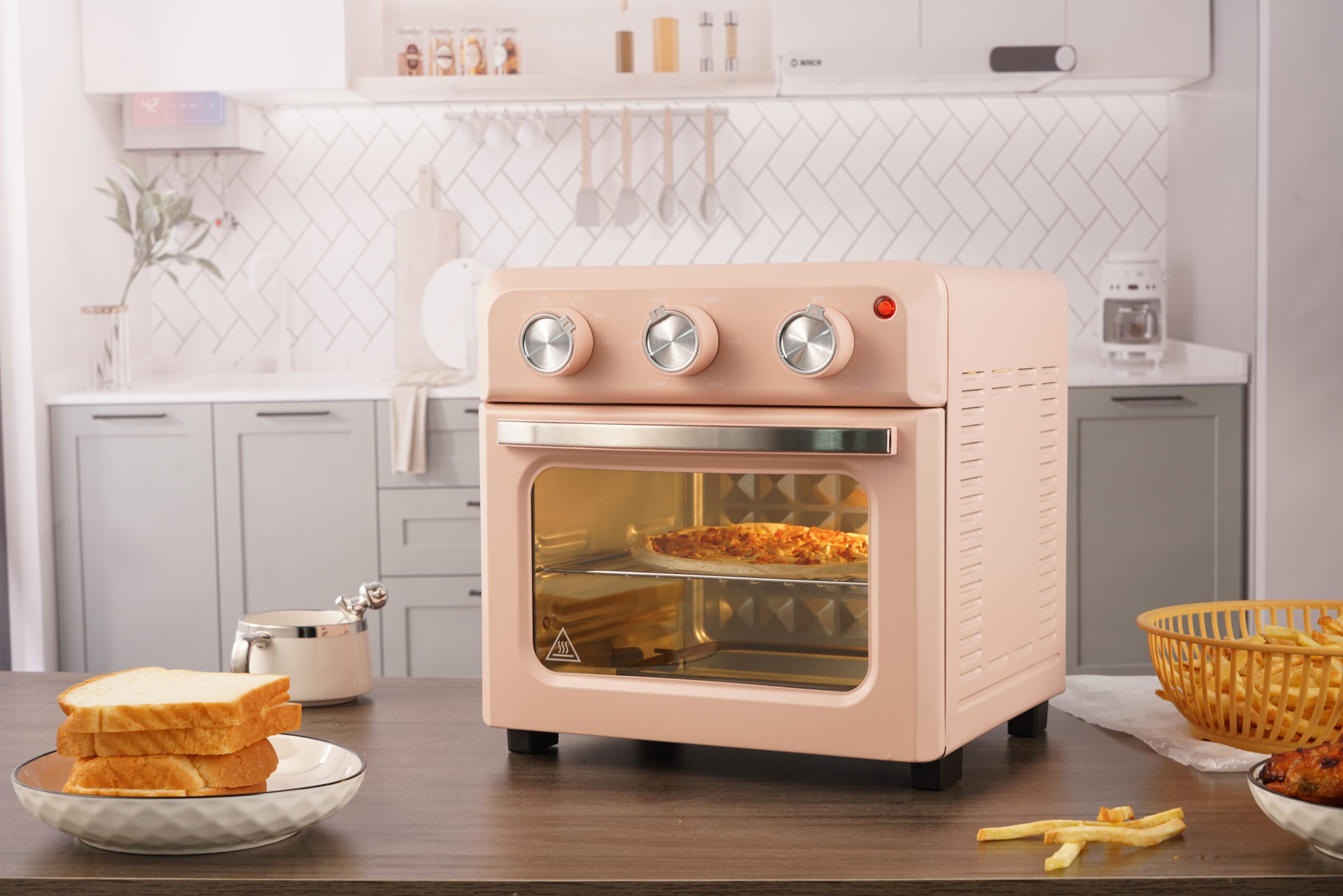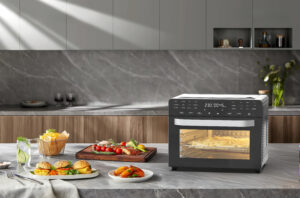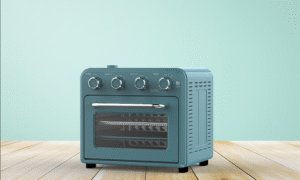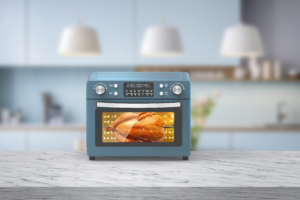Meta Title: Air Fryer Oven vs. Convection Oven: Best Heat Distribution for Cooking
Meta Description: Compare air fryer ovens and convection ovens for heat distribution. Learn which appliance cooks more evenly for perfect meals, with expert insights.
Permalink: /air-fryer-oven-vs-convection-oven
As the Sales Manager at Foshan Linden Intelligent Appliances Co., Ltd., I’ve had the privilege of working closely with innovative kitchen appliances that make cooking a joy. Our 12L, 16L, and 30L air fryer ovens are crafted to deliver exceptional performance, and I’m passionate about helping home cooks choose the right tools. One question I often hear is: Air fryer oven vs. convection oven—which offers the best heat distribution? Heat distribution is critical for even cooking, whether you’re baking, roasting, or frying. In this article, I’ll dive into how these appliances compare, drawing on my expertise to help you decide. Let’s explore the science and practicality behind their heat distribution!
Why Heat Distribution Matters in Cooking
Even heat distribution ensures food cooks uniformly, avoiding undercooked centers or burnt edges. It’s the key to perfectly roasted vegetables, juicy meats, and golden baked goods. At Foshan Linden, we design our air fryer ovens with precision heating in mind. But how do they stack up against convection ovens? I’ll break down their technologies, performance, and suitability for various dishes to find out which excels in heat distribution.
What Is an Air Fryer Oven?
An air fryer oven uses rapid hot air circulation to cook food, mimicking the crispy results of deep frying with minimal oil. Our 12L, 16L, and 30L models combine air frying, baking, roasting, and dehydrating functions. A powerful fan circulates hot air around the food, ensuring consistent heat exposure. This makes them ideal for busy kitchens seeking versatility and efficiency.
What Is a Convection Oven?
A convection oven also uses a fan to circulate hot air, but it’s typically larger and designed for baking, roasting, and broiling. Unlike traditional ovens, convection ovens distribute heat more evenly, reducing hot spots. They’re a staple in many kitchens, but do they outperform air fryer ovens in heat distribution? Let’s find out.
Heat Distribution: Air Fryer Oven vs. Convection Oven
Heat distribution is about how evenly an appliance delivers heat to food. Let’s compare the two based on their technology and real-world performance.
Air Fryer Oven: Intense, Focused Heat Circulation
I’ve seen our air fryer ovens work magic in the kitchen. Their compact chambers and high-powered fans create a vortex of hot air, typically at 350–400°F, that surrounds food from all angles. This rapid air technology ensures even cooking, especially for smaller batches. For example, a 12L air fryer oven can roast a tray of vegetables in 15 minutes, with each piece perfectly caramelized.
The smaller cooking chamber enhances heat concentration, reducing cold spots. Our models feature adjustable temperature controls and accessories like rotating baskets, which further improve heat exposure. According to CNET, air fryer ovens excel at quick, even cooking due to their compact size and intense airflow.
However, air fryer ovens have limitations. Overcrowding the basket can block airflow, leading to uneven results. For larger meals, you may need to cook in batches, though our 30L model accommodates bigger portions.
Convection Oven: Broad, Consistent Heat Spread
Convection ovens are designed for larger-scale cooking. Their fans circulate hot air across spacious interiors, ensuring consistent temperatures. This makes them great for baking multiple trays of cookies or roasting a whole chicken. Per Bon Appétit, convection ovens reduce cooking times by up to 25% compared to traditional ovens, thanks to their even heat distribution.
However, convection ovens may have slight temperature variations in larger chambers, especially in older models. They also take longer to preheat, which can slow down meal prep. For small portions, the large interior may not be as efficient as an air fryer oven’s focused heat.
Heat Distribution Verdict
Air fryer ovens shine for smaller portions and quick meals, delivering intense, uniform heat in a compact space. Convection ovens are better for large-scale cooking, offering consistent heat across bigger trays. For families cooking smaller dishes, our air fryer ovens provide superior heat distribution.
Cooking Performance: Meat and Vegetables
Heat distribution directly impacts how well appliances cook meat and vegetables. Let’s see how each performs.
Air Fryer Oven: Crispy and Even Results
Our air fryer ovens are a favorite for their ability to cook meat and vegetables evenly. The rapid airflow creates a crispy exterior while keeping the interior juicy. For instance, a 16L air fryer oven can cook chicken thighs in 20 minutes at 380°F, with a golden crust and tender meat.
Vegetables like zucchini or sweet potatoes come out perfectly roasted, with caramelized edges. The rotating accessories in our models ensure every side gets equal heat exposure. This makes air fryer ovens ideal for quick, family-friendly meals with consistent results.
Convection Oven: Versatile for Large Batches
Convection ovens excel at cooking larger quantities. They can handle whole roasts or multiple trays of vegetables without hot spots, thanks to their broad heat circulation. A convection oven can bake a tray of potatoes or a large casserole with even browning, as noted by Serious Eats.
However, smaller portions may not cook as efficiently, as the large chamber requires more time to reach optimal temperatures. The results are still excellent, but the process is slower compared to an air fryer oven.
Performance Verdict
For small to medium dishes, air fryer ovens offer faster, more even heat distribution. Convection ovens are better for large roasts or multi-tray baking, where their spacious interiors shine.
Energy Efficiency and Heat Distribution
Energy efficiency ties into heat distribution, as better heat delivery reduces cooking time and energy use.
Air Fryer Oven: Compact and Energy-Saving
Our air fryer ovens are designed for efficiency. Their smaller size means they heat up quickly and use less energy. According to Energy Star, smaller appliances like air fryer ovens can save up to 50% more energy than full-sized ovens for similar tasks. The focused heat distribution minimizes wasted energy, making them eco-friendly for daily use.
Convection Oven: Higher Energy Use
Convection ovens, while more efficient than traditional ovens, consume more energy due to their larger size and longer preheating times. They’re better suited for big meals where their capacity justifies the energy use. For small dishes, they’re less efficient than air fryer ovens.
Energy Verdict
Air fryer ovens win for energy efficiency, thanks to their compact design and rapid heat distribution. They’re ideal for families looking to save on energy bills.
Ease of Use for Home Cooks
Ease of use is crucial for busy households. Let’s compare how these appliances fit into daily life.
Air Fryer Oven: Quick and Intuitive
I love how user-friendly our air fryer ovens are. With digital controls and preset programs, you can set the temperature and walk away. Our 12L model, for example, can whip up a batch of fries in under 15 minutes with minimal effort. Cleanup is simple, with nonstick baskets and dishwasher-safe parts.
The compact size fits any kitchen, and the customizable settings let you fine-tune heat distribution for different dishes. This makes air fryer ovens a go-to for quick, evenly cooked meals.
Convection Oven: More Setup Required
Convection ovens require more setup, including preheating and adjusting racks for optimal airflow. While they’re versatile, the learning curve is steeper, especially for precise baking. Cleanup can also be more involved, with larger trays and interiors to scrub.
Ease of Use Verdict
Air fryer ovens are easier to use for quick meals, with intuitive controls and minimal maintenance. Convection ovens are better for complex, large-scale cooking but require more effort.
Design and Kitchen Appeal
At Foshan Linden, we know aesthetics matter. Our air fryer ovens come in sleek, modern designs with warm color tones, blending seamlessly into any kitchen. Convection ovens, often built-in or larger, prioritize function over style. For families who value a cohesive kitchen look, an air fryer oven adds a touch of elegance.
Cost and Practicality
Air fryer ovens, like our 12L and 16L models, are generally more affordable and compact, making them accessible for most households. Convection ovens, especially high-end or built-in models, can be pricier and require more space. For families with small kitchens, air fryer ovens are the practical choice.
Final Thoughts: Which Offers the Best Heat Distribution?
Choosing between an air fryer oven and a convection oven depends on your cooking needs. For small to medium meals, our 12L, 16L, and 30L air fryer ovens at Foshan Linden deliver superior heat distribution, thanks to their compact design and rapid air technology. They’re perfect for quick, evenly cooked dishes that suit busy families.
Convection ovens excel for large-scale cooking, offering consistent heat across bigger trays. They’re ideal for holiday feasts or baking enthusiasts but may not match the speed and efficiency of air fryer ovens for daily use.
As an expert in kitchen appliances, I lean toward air fryer ovens for their precise heat distribution and versatility. They align with our mission to provide innovative, high-quality solutions for home cooks. Visit www.lindensmart.com to explore our air fryer ovens and see how they can elevate your cooking with perfect heat distribution.
Word Count: 1530





